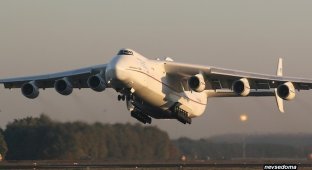Cri Cri is the smallest twin-engine aircraft in the world! (24 photos + 6 videos)
"During the flight, I feel like I'm sitting in a lift-up seat, and although I'm 10 kg heavier than the rest of the plane, it's extremely good for air travel, says plane tester Robert Buisson..."

Cri Cri is the creation of French engineer Michel Colomban. This plane looks more like a large model than a real plane. And yet, with a span of 4.9 m and a flight weight of 170 kg, this is a full-fledged twin-engine aircraft!

Who today does not know, at least in the circles of light aviation enthusiasts, the name and vicissitudes of a small twin-engine aircraft called the “Cri-Cri” - an aircraft that could be seen at many aviation festivals and which became the subject of numerous articles and press publications.. .
It all started in 1958, when the first mention of a small single-seat aircraft with two engines with a total power of 20 hp appeared. These were the years of rapid development of home aircraft manufacturing. But circumstances did not allow the designer from Rueil-Malmaison to realize his dream. What, they “abandoned” “Kri-Kri”? Will he ever appear? How long will it remain on paper? These were the main questions asked by numerous amateur designers.
Only in September 1970, 12 years later, the designer began work with the active help of his wife. There were many requirements for the prototype. It was assumed that this would be the smallest, fastest and most economical production aircraft that would meet the concept of “an aircraft for everyone.” Construction of the prototype began in 1972 in the designer's garage. After 1200 hours of work, the plane was ready.

So, his twin-engine “mini”, weighing 63 kg and resembling a large model rather than a manned aircraft, aroused the surprise and interest of many aviation enthusiasts. At first glance, he looked unusual. The simple angular shape of the fuselage, the unusually large “streamlined” cockpit canopy, as well as two engines mounted on pylons in the forward part of the fuselage - all this looked strange and tempting. First of all, this relates to the arrangement of the engines, which is unique (at that time) in world practice.
The first flight of the MK-10 "Cree-Cree" (F-WTXJ) prototype took place on July 19, 1973. In front of a small group of spectators, photographers and television cameramen, Robert Buisson, a 68-year-old pilot with more than 12,000 flight hours, took off from earth an unusual plane. In flight, "Kri-Kri" resembled a small fighter...
In Germany, at an aircraft model competition, a funny incident happened with this plane. Naturally, everything that happened was planned in advance. Since the plane looks more like an airplane model, one of the “spectators” was offered a ride on the “model”, he agreed))). The man was seated in the cockpit in front of everyone, the pilot on the ground took the remote control and began to “take the model” to the start. I took off safely, made a couple of circles over the airfield and then panic began, the “pilot” announced that he had lost control of the model and there was a man there! While he was trying to “restore communication,” the plane disappeared from view. Imagine the state of the public before whose eyes the “tragedy” played out! But as you may have guessed, everything ended well)))

Flight characteristics of "Cri-Cri":
total wingspan, m 4.9
wing chord (without flaps), m 0.48
wing chord (with flaps), m 0.63
total wing area, sq.m 3.1
V wing (from the root), deg 4
total length of the aircraft, m 3.91
total height of the aircraft, m 1.2
range G.O, m 1.55
chord G.O, m 0.395
chassis track, m 1.1
chassis base, m 1.15
diameter x pitch of propellers, m 0.695 x 0.95
engine, 2 pcs. JPX PUL-212 15 HP
fuel tank capacity, l 23
maximum empty weight, kg 75
maximum take-off weight, kg 170
Max. dive speed, km/h 280
Max. cruising speed, km/h 200
Max. rate of climb, m/s 6.5
ceiling, m 5000
run, m 100
mileage, m 150
fuel consumption, l/100 km 5
Max. overload, g +10/-5
Max. aerodynamic quality 11
The plane can continue to take off with one engine running. The rate of climb is 1.5 m/s.
All-metal construction.
Working drawings: https://airspot.ru/book/file/1068/cri_cri.pdf

















There is also an electric version
And even jet
As you can see, the aircraft is equipped with “aircraft model” engines. Both internal combustion engines, electric and jet engines!
Model flight video
Video of the flight of the model from EPO
Of course you can buy a ready-made model. But due to the simplicity of the design of the model’s contours, it is not difficult to build it yourself using foam technology, cutting out parts with a heated string or using “ceiling” technology. Fortunately, the drawings are online.
Hall model
Personally, I have a priority to build this model! I hope there are people who are interested in this baby.
Clear skies and successful flights to everyone!
When writing this article, materials from the site aviajournal.com were used.
So, how can you get your hands on a Cri-Cri plane? Actually, there are only three ways:
1. The easiest way, which is also the riskiest, is to buy a used plane.
In Russia, it is almost impossible to find such an offer for sale, so the path is to English-language sites. At the time of writing, the cost of a foreign “Cricket” ranged from 7 to 10 thousand euros. The dangers are still the same - engines. More than half of all Kri-Kri accidents occur due to engine failure, so special attention is paid to their selection and maintenance. The most preferable purchase options here may be “Cricket” - this is the name of the models produced by Zenair.
2. The second way is to purchase a new aircraft from one of the assemblers.
We were unable to find at least one official assembler of Kolomban aircraft in Russia. However, there are several companies that produce “analogues” - that is, aircraft that are similar in appearance to the Kri-Kri, but differ in production technology. The most popular deviation from the canon is the fuselage materials. In the original version, the plane is almost entirely metal, while “optimizers” prefer to use wood or composite materials. The cost of such models usually does not exceed 10 thousand euros, excluding the price of engines.
3. Finally, the most reliable and official way is to contact Michel Colomban, buy the plans and assemble the plane yourself.
The cost of a set of drawings varies from 500 to 700 euros and depends only on the mood of the designer himself. The drawings are very detailed, most of them are made on a 1:1 scale. The drawings are accompanied by instructions, which, according to Colomban, can be understood by anyone who has ever opened the hood of a car. However, in addition to the papers, the buyer will receive an invaluable opportunity to communicate with the concept artist himself, ask him questions and receive recommendations on the use, for example, of the same engines.



The Kri-Kri documentation consists of:
* 42 detailed drawings with a format of 1.2 m X 0.6 m, which depict parts, components and assemblies of the aircraft, most often on a scale of 1: 1, as well as a complete list of all parts (approximately 1100 pieces).
* design guide in three parts:
part 1: “General operations” in 30 chapters describing work with drawings, with various materials, riveting, gluing, etc.;
part 2: “Special operations” in 8 chapters, describing methods of manufacturing individual parts, assembly and installation of each element of the aircraft;
part 3: “Tests on the ground and in flight” in 17 chapters of which the propeller-engine group is described: all procedures necessary to ensure normal operation of the power plant;
Also included: Complete list of materials with suppliers' addresses; a list of materials that can replace hard-to-get materials; list of administrative procedures (for the French);
The cost of the complete set is approximately 410 Euro.
For those who decide to assemble the plane themselves, you should write a letter or send a fax to Michel Colomban:
Michel Colomban
37 Bis Rue La Kanol
92500 Rueil Malmaison, France
Fax: 0033 147 51 8876
tel.: 47.51.88.76
Good luck in your endeavors!






















